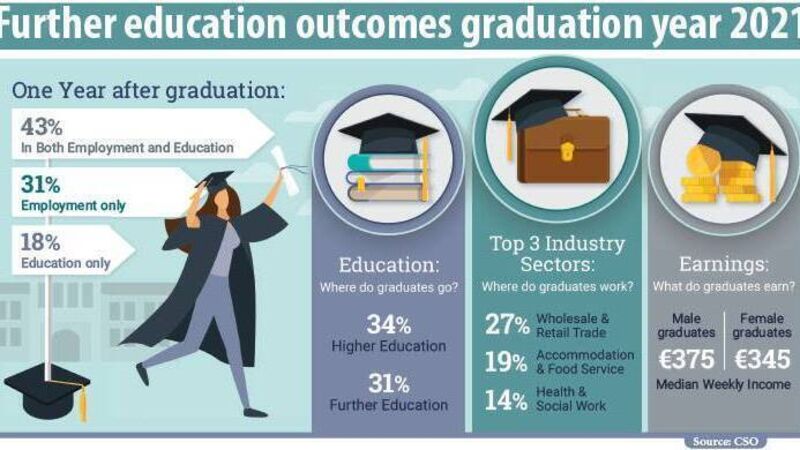More than 90% of further education graduates in jobs or courses after one year

Of the 2021 graduating students, more than a third had enrolled in higher education, with a further 31% embarking upon additional further education.
More than 90% of graduates of further education in 2021 were either employed or still accessing either further or higher education — or both — a year after graduation, according to newly published statistics.
The information, released by the Central Statistics Office (CSO) on Monday, shows that 43% of those graduating from further education in 2021 were both working and continuing to study one year later, while 31% were in employment only, and 18% were in education only.
The CSO described that 74% of the cohort were working in “substantial employment” in their first year after graduation, an increase from the 62.1% of 2016 graduates noted as being in the same situation.
Of the 2021 graduating students, more than a third had enrolled in higher education, with a further 31% embarking upon additional further education.
Those students graduating from communications and technology-based courses were most likely to opt for higher education a year after graduation, while those who had come from agriculture or veterinary courses were more likely to continue in further education.
Further education, defined as any post-secondary school study below degree level, is traditionally seen as an alternate path to acquiring a higher education qualification.
Neither mature students nor graduates enrolled in apprenticeships were covered by the CSO’s report.
In terms of where graduates subsequently found employment, the CSO said that wholesale and retail trade, accommodation and food services, and health and welfare were the dominant sectors, with 60% of those noted as being employed post-graduation working in one of those areas.
Separately, in relation to which graduates were more likely to be employed one year after leaving their course, the CSO said that the highest levels of employment were seen in the health and welfare, engineering and manufacturing, and services sectors.
Income-wise, the median weekly pay for men one year after graduating was €375, while for women it was €345. Both figures represent an increase from their 2016 levels when weekly pay levels were €55 and €65 less for males and females, respectively.
While overall employment levels of further education graduates increased significantly between 2016 and 2021, fluctuations were noted amid that period, with just 59.3% of 2019 graduates noted as being so employed one year after graduation — a likely result of the advent of the covid-19 pandemic in early 2020.

Regarding the 2021 graduating class, the CSO said that more men than women had enrolled in both higher and further education one year out from finishing their further education area of study.
Separately, the CSO’s 2021 report — itself an update of a previously-published report on the further education and training sector between 2010 and 2016 — noted that there was a substantial decrease in the proportion of further education graduates who enrolled in additional education more than one year after their initial graduation.
The sector noting the highest number of graduates to remain in education was the natural sciences, mathematics, and statistics, with 74% of those enrolling in higher education within a year.
The CSO said that the information had been collated using an anonymised statistical framework of its own design.
Its senior statistician, Kieran Culhane, said the CSO treats “all data with strict confidentiality and never” discloses any data that could subsequently be associated with any person or business”.
“We have compiled these new statistics using anonymised records and will only produce statistical results at an aggregate level,” Mr Culhane said, adding that “no individual can ever be identified from the data we publish”.













